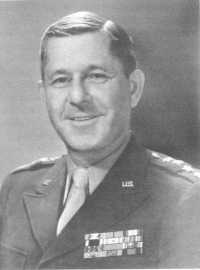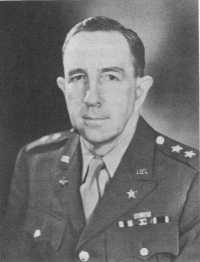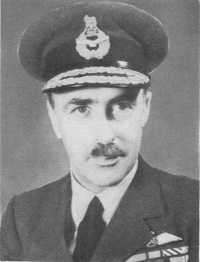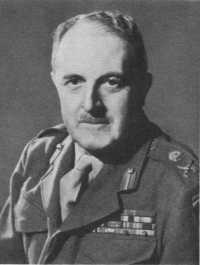Chapter 3: The Nature of SHAEF
Supreme Headquarters, Allied Expeditionary Force, was formally established in London in mid-February 1944, but it had actually been in the process of development for more than two years. It drew its basic principles of organization and many of its key personnel from two headquarters which had been established many months before. One of these, Allied Force Headquarters (AFHQ), which had served as General Eisenhower’s command post in the Mediterranean theater, had provided a laboratory for testing principles and procedures of the command and training of U.S. and British staffs in combined operations. The other, Headquarters, Chief of Staff to the Supreme Allied Commander (COSSAC), had been established in the spring of 1943 to plan the cross-Channel attack and to serve as the nucleus for the ultimate Supreme Headquarters.
Contributions of AFHQ
The importance of AFHQ’s contribution to the SHAEF organization was expressed in General Eisenhower’s postwar judgment that some of his key advisers in northwest Europe had learned “during the African campaigns, the art of dealing with large Allied forces, operating under single command.” At AFHQ, General Eisenhower had developed an integrated command in which British or U.S. officers of a staff division could make decisions affecting forces of either nationality. Officers were carefully selected for their ability to fit into such a staff. Many of them, otherwise capable, were transferred when found unsuitable for such an assignment. The task, as Air Chief Marshal Sir Arthur W. Tedder, the Deputy Supreme Commander of SHAEF, later testified, involved “getting the right people and being ruthless ... and you must be ruthless. ... If a man does not fit he will never learn .the language and you will never make a team; that is the guts of the whole thing, the team. ...”1 U.S. officers who were not wholly in accord with General Eisenhower’s weeding-out process had a grim joke to the effect that the way to get sent back to the United States “by slow boat” was to say something insulting about a foreign officer of the headquarters. Others charged the British with using the complaint that certain officers were un-cooperative to rid the headquarters of United States officers who were aggressive in defending the American point of view. To General Eisenhower, the important thing was to establish a completely Allied headquarters. When he went to SHAEF he was able to take key advisers from AFHQ and be certain that he would have
General Devers (photograph taken in 1946)
General Barker
men who were thoroughly sold on Allied cooperation.
As Allied commander in chief in the Mediterranean theater, General Eisenhower learned the métier of Supreme Command and became familiar with most of the problems he later faced at SHAEF. Questions such as the recognition of a French political authority, the formulation of civil affairs and military government programs, the proper handling of press relations, the expansion of the psychological warfare program, and the establishment of air-ground cooperation all reappeared in the European Theater of Operations. Not only had the Supreme Commander been schooled in the techniques of approaching these problems, but he trained a staff that was also familiar with them. Ultimately Allied Force Headquarters furnished SHAEF with the Supreme Commander, Deputy Supreme Commander, chief of staff, chief administrative officer, chief of intelligence, deputy chief of operations, deputy chief of civil affairs, chief of press relations, chief of the psychological warfare division, and adjutant general. The British Chiefs of Staff in filling key command and staff positions for the invasion of northern France also drew on the Mediterranean for a number of men acquainted with Eisenhower and his staff. This list included the chiefs of staff of the Allied Expeditionary Air Force and the Allied Naval Expeditionary Force; the commander of British land forces and his chief air commander; and the British army commander for the invasion. The
Canadian commander had also served in Italy. United States officers who had formerly served under General Eisenhower in the Mediterranean before coming to the United Kingdom included the chief of the United States Army Air Forces in Europe, the commander of the Eighth Air Force, and the commanders of the two U.S. armies listed for participation in the early phases of the attack.
Contributions of COSSAC
In many ways, Supreme Headquarters was a continuation of the COSSAC staff which had been organized in April 1943 along lines discussed by the Combined Chiefs of Staff in January 1943 at Casablanca and modified in March and April. General Morgan, as Chief of Staff to the Supreme Allied Commander (Designate), had been directed to prepare a diversionary plan with the object of pinning the enemy in the west and keeping alive the threat of a cross-Channel attack in 1943 (COCKADE), to plan a return to the Continent in the event of German disintegration (RANKIN), and to plan a full-scale assault on the Continent as early as possible in. 1944 (OVERLORD).2
The COSSAC staff was developed throughout 1943 on the basis that it would serve ultimately as the staff of the Supreme Commander. Its chief and many of its members were taken into the SHAEF organization. It was thus possible not only to preserve but also to draw upon the ideas of early planning groups which had preceded COSSAC.
Before his appointment as COSSAC chief, General Morgan had recommended that a staff be formed immediately as “the nucleus of the eventual Allied GHQ in the field” and that it be prepared at the earliest moment to assume direction of all offensive enterprises initiated from the United Kingdom. He proposed to combine from the beginning all functions of planning and execution and to direct all future activity toward the defeat of the German Army. He desired complete amalgamation of the U.S. and British services in the machinery of the high command with the understanding that the ultimate issue would be decided by the Allied strategic reserve of land forces, “namely the American army.”3
General Morgan set up his staff in London at Norfolk House, St. James’s Square, built on the site of the birthplace of George III of England. With the aid of his U.S. deputy, Maj. Gen. Ray W. Barker, the COSSAC chief began to select the future SHAEF staff and to outline the operations which the future Supreme Commander was to carry into effect. When, in the late summer of 1943, it became clear that an American officer would become the Supreme Commander, he sought to place Americans in a number of key spots and to
reorganize COSSAC: along American lines. Much of this work was handed over to General Barker, the ranking U.S. officer at the headquarters. As a result of this shift, two U.S. officers were brought to London as deputy chiefs of the operations and supply sections with the understanding that they would later head these two sections under the Supreme Commander. General Eisenhower’s chief of publicity and psychological warfare and members of the civil affairs section of Allied Force Headquarters were also brought to COSSAC in the fall of 1943 to prepare for roles in SHAEF.4
General Marshall, in September 1943, at the time when it was assumed he would lead the cross-Channel operation, told General Devers, Commanding General, ETOUSA, that full support must be given General Morgan “in his difficult task of organizing an efficient, operational staff for our Supreme Commander.” General Marshall suggested that the Supreme Headquarters have General Morgan as chief of staff, U.S. officers as deputy chief of staff and chief of operations, a British officer as chief of intelligence, and a British officer as chief of administration until the bulk of supplies began to come from the United States, at which time he would be replaced by a U.S. officer. Marshall proposed that the press and propaganda sections be headed by U.S. and British officers with coequal powers. He added that in each staff section the second in command was to be of the nationality opposite to that of his chief. In order that the staff should be well balanced, General Marshall recommended strong naval, air, and ground representation, with a possible reduction of naval representation after the initial assault. The Allied naval and air staffs were to be of a size necessary “to effect the coordinated direction of the forces” under their commands.5
Both General Marshall and General Morgan believed that the ultimate Supreme Headquarters should be modeled on Marshal Foch’s World War I staff, described by the COSSAC chief as a “really small body of selected officers who dealt with the major decisions on broad lines, the day-to-day work of the war being delegated completely to the commanders of army groups.”6 Such a headquarters would have been sufficient only for a Supreme Commander who was merely chairman of the Allied forces. Once it became clear that General Eisenhower would direct operations, the need for a larger staff became apparent.
The appointment of General Eisenhower as Supreme Commander also required other changes in the COSSAC plans. It was natural that the new commander, having developed a satisfactory staff at Allied Force Headquarters, would want to bring a number of his advisers with him. Even before he assumed his new post, General Eisenhower directed General Smith to study the personnel situation
for SHAEF. This officer, after studying the COSSAC organization, proposed changes in it based on Allied experiences at AFHQ. He initially asked for an enlarged staff, on the ground that the existing organization was not large enough for a commander who intended to control operations in the field. Fresh from the Mediterranean headquarters, General Smith was aware that civil affairs, press relations, psychological warfare and other such activities of an Allied headquarters would require large staffs. To fill these and other posts in the new SHAEF organization he began to draw on Allied Force Headquarters for key officers whose names had already been suggested by General Eisenhower.7
A steady flow of personnel northward began in January 1944 and increased until the British Chief of the Imperial General Staff feared that the new Supreme Commander, Mediterranean, would not have enough experienced officers to run his headquarters. The new arrivals introduced changes in several COSSAC divisions, although an attempt was made to retain most of the COSSAC members and reassure them about the intentions of the new regime. General Eisenhower at the outset made clear that he had no purpose of sweeping clean the organization which was already functioning in London. Rather he wished “to integrate himself upon the existing staffs in SAC”8 and develop the same unity of action which had prevailed in the Mediterranean. General Morgan was made deputy chief of staff of SHAEF, General Barker was placed at the head of one of the general staff divisions, and other key members of the COSSAC staff were retained in their positions. By selecting men from both headquarters who were faithful to the idea of “integration,” the Supreme Commander was able to make the transition without serious disturbance, although several division heads were replaced and other personnel shifted. For a time the COSSAC members, who had been planning the cross-Channel invasion for a number of months, resented the newcomers’ boasts of the “sand in their boots” they had picked up in North Africa. The Allied Force Headquarters officers, for their part, often complained that the COSSAC people lacked real knowledge of combat and were inclined to be academic in their approach to operational planning. Both groups, in time, found it necessary to coalesce in the face of British and U.S. combat soldiers from the Mediterranean theater who were inclined to smile at the suggestion that members of high level headquarters knew anything about battle conditions. By the eve of the invasion, the integrated SHAEF staff was functioning as an efficient unit.9
The Chief Deputies
Air Chief Marshal Tedder was chosen as Deputy Supreme Commander of SHAEF in January 1944. General Eisenhower did not have a hand in his selection, but he was highly pleased that the British made this choice. The two men had been closely associated in the Mediterranean
Air Chief Marshal Tedder
theater and shared the same views on the integration of Allied staffs. General Eisenhower had proposed Tedder for the post of chief airman at SHAEF before he knew that the British officer was being considered for the post of deputy. Tedder had served as British air commander in the Middle East in 1942, helping to stop Generalfeldmarschall Erwin Rommel’s advance toward Egypt. The air marshal’s forces had also contributed significantly to the success of General Montgomery’s El Alamein attack and the subsequent drive toward Tunisia. From 17 February 1943 until his appointment as Deputy Supreme Commander, Tedder had served as Commander in Chief, Mediterranean Allied Air Forces, which included RAF Middle East, RAF Malta Air Command, and the Northwest African Air Forces. The Northwest African command included British and U.S. air forces in support of General Eisenhower. In the Mediterranean post, Tedder came to be held in high esteem by many of the U.S. and British airmen who were later brought to the United Kingdom to command various air units in support of the cross-Channel attack. German intelligence agencies showed a wholesome respect for the new deputy. Shortly after his selection, one of them reported:–
Tedder is on good terms with Eisenhower to whom he is superior in both intelligence and energy. The coming operations will be conducted by him to a great extent. He regards the Air Force as a “spearhead artillery” rendering the enemy vulnerable to an attack. His tactics in North Africa, Sicily and Italy, based on this theory, provided for air support for the advance of even the smallest Army units. ... Under Tedder’s influence the cooperation between the Air Force and Army has become excellent.
Tedder does not take unnecessary risks. Unless other factors play a part, he will undertake the invasion only after achieving complete air supremacy and after large-scale bombing of the Reich.
Tedder is said to be taciturn especially since he lost his eldest son in an air battle over London. He is very popular with the troops on account of his consideration and unassuming appearance.
Obviously we are dealing here with one of the most eminent personalities amongst the invasion leaders.10
Air Chief Marshal Tedder became the chief coordinator of Allied air efforts in support of the cross-Channel operation. The Deputy Supreme Commander made no effort to form a special staff through which to deal with air activities, restricting his function in many cases to that of a
chairman or moderator of daily air conferences at which the chief strategic and tactical air commanders were represented. He also worked with the Air Staff (SHAEF) which was set up under a separate deputy chief of staff for air.
Tedder participated in General Eisenhower’s morning conferences, giving advice both as Deputy Supreme Commander and as chief airman. The demands of air activities on his time and the fact that Tedder was not a ground force officer led many members of the SHAEF staff to consult him only on air matters. General Eisenhower used his deputy frequently to explain SHAEF policy to the British Chiefs of Staff and occasionally sent him on highly important missions, such as that to Moscow in January 1945. In the early months of the OVERLORD operation, the Supreme Commander charged his deputy with the task of insuring that ground commanders asked for and got the air support necessary for their operations. Tedder also intervened directly when he felt it necessary to bar projects that he considered wasteful of planes or contrary to existing doctrines of proper employment of air forces in combat. In all these assignments, he worked quietly and effectively, taking many problems, particularly those relating to the air forces, off the Supreme Commander’s shoulders.11
General Eisenhower had chosen as his chief of staff at SHAEF the officer who had held a similar post in the Mediterranean theater.12 Prime Minister Churchill suggested that General Smith stay at Allied Force Headquarters as deputy commander but, in the face of General Eisenhower’s insistence, gave way. Smith had served before the war as Secretary of the General Staff in the War Department and later as secretary to the Combined Chiefs of Staff in Washington. He was thoroughly acquainted with high-level staff work and with the individuals who made up the Supreme Allied Command. Capable of being extremely tough and brusque in manner, he also knew the value of the smooth approach. He was thus useful as a hatchet man for the Supreme Commander, and also qualified to represent him in missions which required diplomatic skill. General Eisenhower considered him a perfect chief of staff.
General Smith guarded the approaches to General Eisenhower somewhat more jealously than the British staff members of SHAEF would have liked. He directed the flow of correspondence into his office and cut down the number of direct contacts between the Supreme Commander and the SHAEF deputies and staff members. Shortly after his arrival Smith made a major change in that direction by reorganizing the Central Secretariat of COSSAC, headed by Maj. Martin McLaren, along lines of the American Secretary of the General Staff system. He attempted to run the new staff for a time with Major McLaren and Col. Dan Gilmer, who had been secretary of the general staff in the Mediterranean, but the experiment proved unsuccessful. Colonel Gilmer went to the War Department as chief of the European theater section of the Operations Division, and Major McLaren to the G-3 Division of SHAEF. Lt. Col. Ford Trimble, onetime aide of Gen. Douglas
General Smith
MacArthur, became secretary of the general staff.13
In accord with American practice all staff studies originating in the SHAEF divisions came to the chief of staff before being passed on to the Supreme Commander. In this way papers that did not need General Eisenhower’s approval were handled by General Smith. Many items of correspondence prepared for the Supreme Commander’s signature were issued by the chief of staff for his chief without being passed on to him. To make certain that General Eisenhower was kept informed of all action, the secretary of the general staff prepared a special log of incoming and outgoing messages which was shown to him each day. Careful lists of all decisions by the chief of staff were kept for the inspection of the Supreme Commander. The chief of staff held his own daily morning conference just before that of the Supreme Commander. In the latter conference it was possible for key U.S. and British members of the staff to present matters directly to the Supreme Commander.
The office of the chief of staff was tightly organized and its head gained the reputation of a driver. His ruthless cutting of verbiage from papers and his demand for clearly stated proposals were a great aid to efficiency. At the risk of exercising some of the functions that belonged to the Deputy Supreme Commander, he also saved General Eisenhower from many details of administration which could have become overwhelming. While in London, General Smith saw the Prime Minister and members of the British Chiefs of Staff frequently and proved helpful to Eisenhower in working out numerous details with them. He was even more valuable in dealing with the French after SHAEF moved to the Continent, consulting with Gen. Alphonse-Pierre Juin and Maj. Gen. Pierre Joseph Koenig on matters pertaining to the liberation of France.
The selection of General Smith as chief of staff filled the place which had previously been intended for General Morgan. Since it was felt that the COSSAC chief might not want to serve in a lesser post at Supreme Headquarters, arrangements were made to offer him command of a British corps. Instead Morgan asked to serve in some capacity in SHAEF. Thereupon, General Eisenhower accepted General Smith’s recommendation that the former COSSAC head become deputy chief of staff. In this post, General Morgan acted from time to time as chief of staff.
He was also given numerous special assignments to coordinate the work of various SHAEF divisions. General Smith after the war described the COSSAC chief as his British alter ego, “a man I wouldn’t willingly have dispensed with.”14
Air Vice Marshal Robb
General Gale
A second deputy chief of staff (chief administrative officer), Lt. Gen. Sir Humfrey M. Gale, came to SHAEF from a similar position at AFHQ at the strong insistence of General Eisenhower. When Field Marshal Brooke demurred at the shift, Smith pointed out that Eisenhower had always felt “he would be unwilling to undertake another large Allied Command without Gale’s administrative assistance .... He has that irreplaceable quality of being able to handle British-American supply problems with tact and judgment and he is almost as familiar with the American system of supply as with the British.” General Gale found his position at SHAEF to be somewhat different from that at Allied Force Headquarters. In the Mediterranean he had also had responsibility for British troops behind the front. In the European theater, 21 Army Group controlled its own supply and the American units had their Headquarters, Communications Zone. At SHAEF, therefore, he had less real control over supply and administration than at Allied Force Headquarters. His duties consisted of coordinating the activities of G-1, G-4, and the supply elements of G-5. He also served as chairman of various high-level committees that dealt with matters of supply.
One of his chief tasks was to anticipate future bottlenecks and to study ways in which they might be avoided.15
The third deputy, Air Vice Marshal James M. Robb, who became Deputy Chief of Staff (Air), had served at one time in the Mediterranean as General Eisenhower’s air adviser. Later he became commander of RAF North Africa and deputy to General Spaatz, commander of the Northwest African Air Forces.16 At SHAEF the air marshal coordinated all correspondence and planning of the various SHAEF divisions in regard to air activities.
The selection of the chief deputies was followed in turn by the naming of the heads of the various divisions—a story which will be told in some detail elsewhere in this volume.17 By mid-January most of the key positions of the headquarters had been filled and Supreme Headquarters was functioning. By mid-February General Eisenhower had his formal directive and his command was officially under way. It is important now to examine what had already been done by SHAEF’s predecessors and what yet remained to be achieved before the offensive against northwest Europe could be launched.





